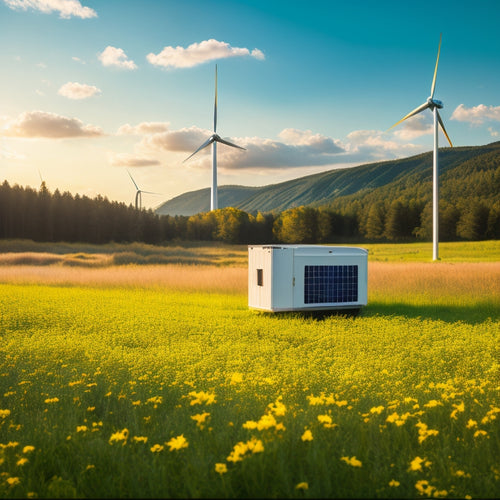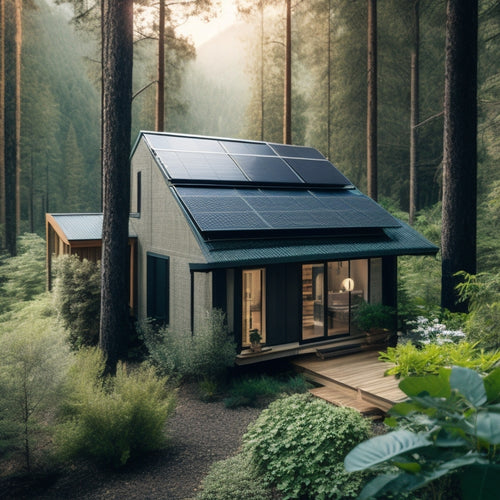
Cut Energy Bills With Home Storage Solutions
Share
You can reduce your energy bills by leveraging home storage solutions to optimize your energy usage patterns, shifting non-essential loads to off-peak hours, and minimizing your reliance on the grid during high-cost periods. By charging your storage systems during off-peak hours, you can use this energy during peak times, reducing your grid dependence and energy costs. Additionally, regular maintenance of your solar panels and smart energy usage tracking can help you identify opportunities to adjust your consumption habits. By implementing these strategies, you'll be well on your way to cutting your energy bills - and there's even more you can do to maximize your savings.
Overview
- Home storage solutions like Tesla Powerwall allow using off-peak energy during peak times, reducing reliance on the grid and energy bills.
- Shifting non-essential loads to off-peak hours with smart meters and analytics enables tariff optimization and lower energy costs.
- Energy storage systems store excess energy generated during off-peak hours for use during peak hours, reducing grid dependence and bills.
- Charging home storage during off-peak hours is cost-effective, and regular maintenance of solar panels ensures peak performance and energy harvesting.
- By optimizing energy usage patterns and shifting to off-peak hours, homeowners can significantly lower their energy bills and carbon footprint.
Reducing Peak Hour Consumption
Consuming less energy during peak hours not only reduces your electricity bill but also takes some load off the grid, helping to prevent brownouts and blackouts. By doing so, you're participating in demand response, a strategy that incentivizes energy efficiency.
To accomplish this, you can adjust your energy usage patterns to off-peak hours when energy rates are lower. For instance, you can charge your home storage solutions during off-peak hours and use that energy during peak hours.
When selecting a DIY solar power system, consider high-efficiency panels that can maximize your energy harvesting. Additionally, regular maintenance, such as cleaning your solar panels every 6-12 months, can guarantee peak performance.
This approach not only saves you money but also reduces the strain on the grid, promoting energy efficiency and independence. By taking control of your energy consumption, you're contributing to a more reliable and sustainable energy future.
Optimizing Energy Usage Patterns
You can optimize your energy usage patterns by implementing peak hour management strategies, tracking your energy usage to identify areas for improvement, and taking advantage of time-of-use optimization to reduce your energy bills.
By understanding your energy usage habits, you can make informed decisions about when to charge your home storage system and when to use stored energy. This approach will help you reduce your reliance on the grid during peak hours and lower your overall energy costs.
By achieving grid independence, you can enjoy uninterrupted power during outages and have more control over your energy needs and consumption.
Additionally, selecting the right renewable energy storage solution can help you store excess energy for nighttime or cloudy day use.
Peak Hour Management
Managing your home's energy usage during peak hours is essential to reducing your overall energy consumption and saving on utility bills. By optimizing your energy usage patterns, you can take control of when and how you use electricity.
This is where energy storage solutions come in. With a home energy storage system, you can store excess energy generated during off-peak hours and use it during peak hours, reducing your reliance on the grid.
For instance, systems like Tesla Powerwall and LG Chem RESU offer up to 12.8 kWh storage advanced tech, allowing you to capture excess renewable energy for later use. This demand response strategy allows you to manage your energy usage effectively, reducing your energy bills and carbon footprint.
Energy Usage Tracking
As homeowners optimize their energy usage patterns, they're likely to uncover opportunities for improvement by closely monitoring their energy consumption.
You can achieve this by utilizing energy monitoring tools that provide real-time data on your energy usage. These tools enable you to analyze your usage behavior, identifying areas where you can make adjustments to reduce your energy bills.
By examining your energy consumption patterns, you'll be able to pinpoint times of high energy usage and identify opportunities to shift non-essential loads to off-peak hours.
This level of visibility enables you to take control of your energy usage, making informed decisions to optimize your energy consumption and reduce your reliance on the grid.
Time-of-Use Optimization
Optimizing your energy usage patterns involves strategically shifting non-essential loads to off-peak hours, reducing your reliance on the grid during peak periods.
With smart meters and energy analytics, you can identify consumption trends and receive usage alerts to adjust your habits.
By leveraging demand response and load forecasting, you can optimize your energy usage to take advantage of tariff incentives.
This is where battery management comes in, allowing you to store excess energy generated from renewable sources, such as solar, and use it during peak hours.
Shifting to Off-Peak Hours
You can considerably reduce your energy costs by shifting your home storage solutions to off-peak hours.
By doing so, you can take advantage of peak hour alternatives, cheap energy times, and nighttime power shifts.
This strategic approach allows you to optimize your energy usage patterns and make the most of your storage solutions.
Peak Hour Alternatives
What if you could save energy and reduce your storage costs by simply shifting your usage patterns? By leveraging load shifting and demand response strategies, you can optimize your energy consumption and minimize your reliance on the grid during peak hours. This not only reduces your energy bills but also enables greater energy independence.
| Time of Day | Energy Demand | Energy Cost |
|---|---|---|
| Peak Hours (5pm-9pm) | High | High |
| Off-Peak Hours (9pm-5pm) | Low | Low |
| Renewable Hours (Solar Noon) | Medium | Medium |
Cheap Energy Times
Energy usage patterns are often driven by daily routines, with peak hours coinciding with dinner preparation, TV time, and other household activities.
You can take advantage of energy pricing trends by shifting your energy-intensive tasks to off-peak hours, typically between 9 pm and 7 am. This strategy can greatly reduce your energy bill.
By comparing energy bills from different providers, you can identify the cheapest times to use energy in your area.
With home storage solutions, you can store excess energy generated during the day and use it during peak hours, further reducing your reliance on the grid.
Nighttime Power Shift
Shifting daily routines to off-peak hours can markedly reduce energy costs, especially during the Nighttime Power Shift between 9 pm and 7 am.
You can take advantage of cheaper energy rates by charging your energy storage systems, like batteries, during this window. This approach optimizes your energy autonomy, reducing reliance on the grid and your environmental impact.
By leveraging advanced battery technology and renewable integration, you can store excess energy generated during the day for use during peak hours. This demand response strategy enhances grid resilience and leads to significant cost savings.
With user-friendly smart systems, you can easily monitor and control your energy usage, making it easier to achieve energy independence.
Minimizing Grid Dependence Costs
By opting for home storage solutions, you're taking a significant step towards reducing your reliance on the grid and, consequently, minimizing your energy bills.
This shift towards energy independence not only reduces your carbon footprint but also yields significant cost savings.
With home storage solutions, you can store excess energy generated during the day for use during peak hours, reducing your dependence on the grid.
This translates to lower energy bills and a more predictable expense profile.
Maximizing Solar Energy Harvest
Your solar panels work tirelessly to capture the sun's rays, converting them into electrical energy that powers your home.
To maximize this energy harvest, it's crucial to perform regular solar panel maintenance. This includes cleaning the panels to guarantee optimal energy absorption and inspecting the system for any signs of wear or damage.
By doing so, you'll make certain your solar panels operate at peak efficiency, generating as much energy as possible.
When combined with advanced energy storage technologies, you'll be able to store excess energy generated during the day for use during the night or on cloudy days, reducing your reliance on the grid and cutting your energy bills.
Avoiding Peak Demand Charges
Most homeowners are unaware that their energy usage patterns can markedly impact their electricity bills, particularly during peak demand hours.
During these times, utilities charge higher rates to manage the increased load on the grid. You can avoid these peak demand charges by leveraging energy storage solutions.
By installing an energy storage system, like a battery, you can shift your energy usage from peak hours to off-peak hours, reducing your electricity bills.
This demand response strategy allows you to store excess energy generated by your solar panels or the grid during off-peak hours and use it during peak hours, reducing your reliance on the grid and your energy costs.
Stabilizing Home Energy Prices
As you optimize your energy usage patterns to avoid peak demand charges, you're likely wondering how to stabilize your home energy prices in the long run.
One key strategy is to hedge against market volatility by investing in home energy storage solutions. By storing excess energy generated by your solar panels or wind turbines during off-peak hours, you can reduce your reliance on the grid during peak hours when prices are highest.
This not only saves you money but also provides a buffer against energy price forecasts that may be affected by market fluctuations.
Frequently Asked Questions
Can I Use Home Storage Solutions With Non-Solar Renewable Energy Sources?
You can utilize wind energy and hydropower systems with home storage solutions, choosing compatible battery types to achieve grid independence, allowing you to break free from reliance on traditional power sources and enjoy energy autonomy.
How Long Do Home Energy Storage Systems Typically Last?
As you commence your energy independence expedition, you'll find home energy storage systems typically last around 10-15 years, with some lasting up to 20, depending on maintenance requirements and meeting lifetime expectations, giving you a decade or more of freedom from grid reliance.
Are Energy Storage Solutions Compatible With My Existing Electrical Panel?
You'll need to check your electrical panel's compatibility with the energy storage system; if it's outdated, you might require electrical upgrades to guarantee a seamless integration, but most systems are designed to be adaptable to your existing setup.
Can I Install Home Energy Storage Systems Myself?
When considering DIY installation, you'll need to weigh the benefits against safety considerations; while you may save on labor costs, improper installation can lead to electrical shock, fires, or system failure, putting you and your home at risk.
Are There Any Government Incentives for Home Energy Storage Systems?
As you traverse the intricate terrain of energy storage, you'll find a silver lining: government incentives! You're eligible for federal rebates, state incentives, energy tax credits, and installation grants, considerably reducing the upfront cost of your home energy storage system.
Ready to Buy
As you utilize the power of home storage solutions, your energy bills will plummet like a rock rolling down a hill. By reducing peak hour consumption, optimizing your energy usage patterns, and shifting to off-peak hours, you'll be dodging grid dependence costs like a pro. With maximized solar energy harvest and avoided peak demand charges, your home energy prices will stabilize like a steady anchor. You'll be the ruler of your energy destiny, saving money and the planet, one kilowatt-hour at a time.
Related Posts
-

Is This the Future of Alternative Energy Systems
Yes, alternative energy systems are shaping the future of energy. Innovations in solar and wind technologies are driv...
-

Sustainable and Eco-Friendly Generators for a Reduced Carbon Footprint
Sustainable and eco-friendly generators are perfect for cutting your carbon footprint and increasing energy efficienc...
-

Off Grid Solar Batteries
As you shift to off-grid living, you'll rely on high-performance solar batteries to store excess energy generated by ...


